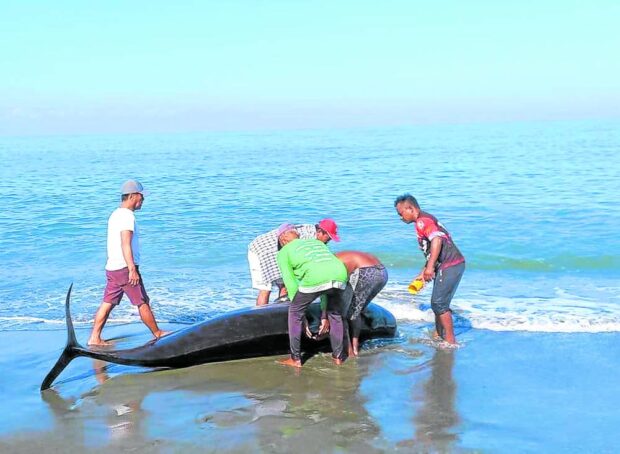Blast fishing eyed in stranding of whales, dolphin in Ilocos

SHORE FIND This short-finned pilot whale stranded on thebeach of Paoay, Ilocos Norte, died despite efforts by local fishermen and volunteers to rescue it. —ARTHUR VALENTE/CONTRIBUTOR
SAN FERNANDO CITY—Three short-finned pilot whales (Globicephala macrorhynchus) and a spinner dolphin (Stenella longirostris) were stranded in different coastal towns of the Ilocos region on Wednesday, marking the first cases of marine mammal stranding in the area this year.
The two pilot whales that beached on the shorelines of Bacnotan town in La Union province and San Vicente town in nearby Ilocos Sur province were successfully released back to the sea, said Hasmin Chogsayan, veterinarian of the Bureau of Fisheries and Aquatic Resources (BFAR) in the region.
She said the other pilot whale found in Paoay town in Ilocos Norte province, was also released, but it lingered in the shallow water before it was rescued again.
According to Chogsayan, marine mammal rescuers and local fishermen provided supportive care for the rescued whale throughout the night and released it the following morning, only to get stranded again in a neighboring village before it died.
She said the dead whale displayed signs of injuries due to traces of blood in its blowhole.
The spinner dolphin found on Saud beach in Pagudpud town, also in Ilocos Norte, was also successfully released to the sea, the BFAR said in a report.
Disoriented
“We are investigating whether the marine mammals fell victim to blast fishing,” Chogsayan said in an interview, noting that the marine mammals exhibited good body condition suggesting that the stranding might be due to disorientation secondary to blast activities.
In a previous interview, Lemnuel Aragones, head of the Philippine Marine Mammal Stranding Network, explained that marine animals washing ashore exhibiting good body conditions might indicate acute factors such as blasting, causing them to lose their acoustic sensors and swim straight until reaching the beach.
BFAR records showed that over 20 marine animals were stranded or beached in the coastal towns of the region last year.
Among these, five were successfully released back to the sea, while others were either found dead or died during rehabilitation.
Reginald Atabay, head of BFAR Ilocos’ fishery protection and law enforcement division, said agency personnel routinely patrol the Lingayen Gulf to monitor illegal fishing activities in the area.
But he said that despite their increased surveillance efforts, some fishermen continue to use banned methods, such as blast fishing.
In October 2023, BFAR and the Marine Mammal Research and Conservation Laboratory of the University of the Philippines in Diliman conducted a cetacean survey in the Lingayen Gulf.
According to the research team’s report, the surveyors deployed hydrophones supposedly to listen to a pod of dolphins they sighted within the deeper portion of municipal waters.
While there were no visible fishing boats, the team recorded blasts in five of the 10 hydrophone deployments, the report said.